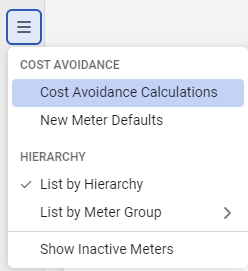Cost Avoidance calculations
The Cost Avoidance processor creates the baseline adjusted to current conditions (BATCC) cost and use values.
BATCC cost and use - current cost and use = cost avoidance cost and use.
Utility Management subscribers see these options in the Sites and Meters module menu.

Utility Company Platform subscribers see these options in the Sites and Meters module menu.


Calculate savings processor
Each time the processor runs, Cost Avoidance values are recalculated and prior values updated if needed. If nothing has changed that affects the prior months it is not necessary to run the processor for prior billing periods.
If you move bills remember to run Calculate Savings for the affected meters.
The Cost Avoidance processor adjusts the raw baseline up or down to current conditions by accounting for:
- Weather
- Floor area
- Billing period length
- Energy unit cost
- Any special adjustments
A best practice is to Calculate Savings for Bills that are not processed or have been modified immediately after entering new bills or editing existing bills. This saves time and prevents unnecessary re-processing. Filters can be set to limit the scope.
The processor runs automatically after:
- Creation or edit of a special adjustment.
- Updates to a meter's baseline.

Should you ignore special adjustments?
Special adjustments should NOT be ignored unless you need to run a what if report that shows the cost avoidance with all or some adjustments turned off.
In that uncommon case, ignore the special adjustment category in question, run the processor, print the report (CAP01B is a good one), then re-run the processor with nothing ignored and print the report again.
The net difference between the two reports is the affect of the ignored adjustments.
Rerun baseline if the baseline changes
Reprocess baseline ONLY because baseline data or settings have changed. Normally this is NOT needed because nothing has changed in your baseline or meter configuration data. This creates unnecessary processing in your database.
If need be (and it seldom is) you can check the ignore weather box to create a non-weather adjusted baseline. Assess the affect of weather by comparing reports with the weather not ignored and ignored.
Cost Avoidance and leap year
If the baseline year is a leap year, February 29th data is overwritten with March 1st data.
If the savings year is a leap year, February 28th data is used to model February 29th.